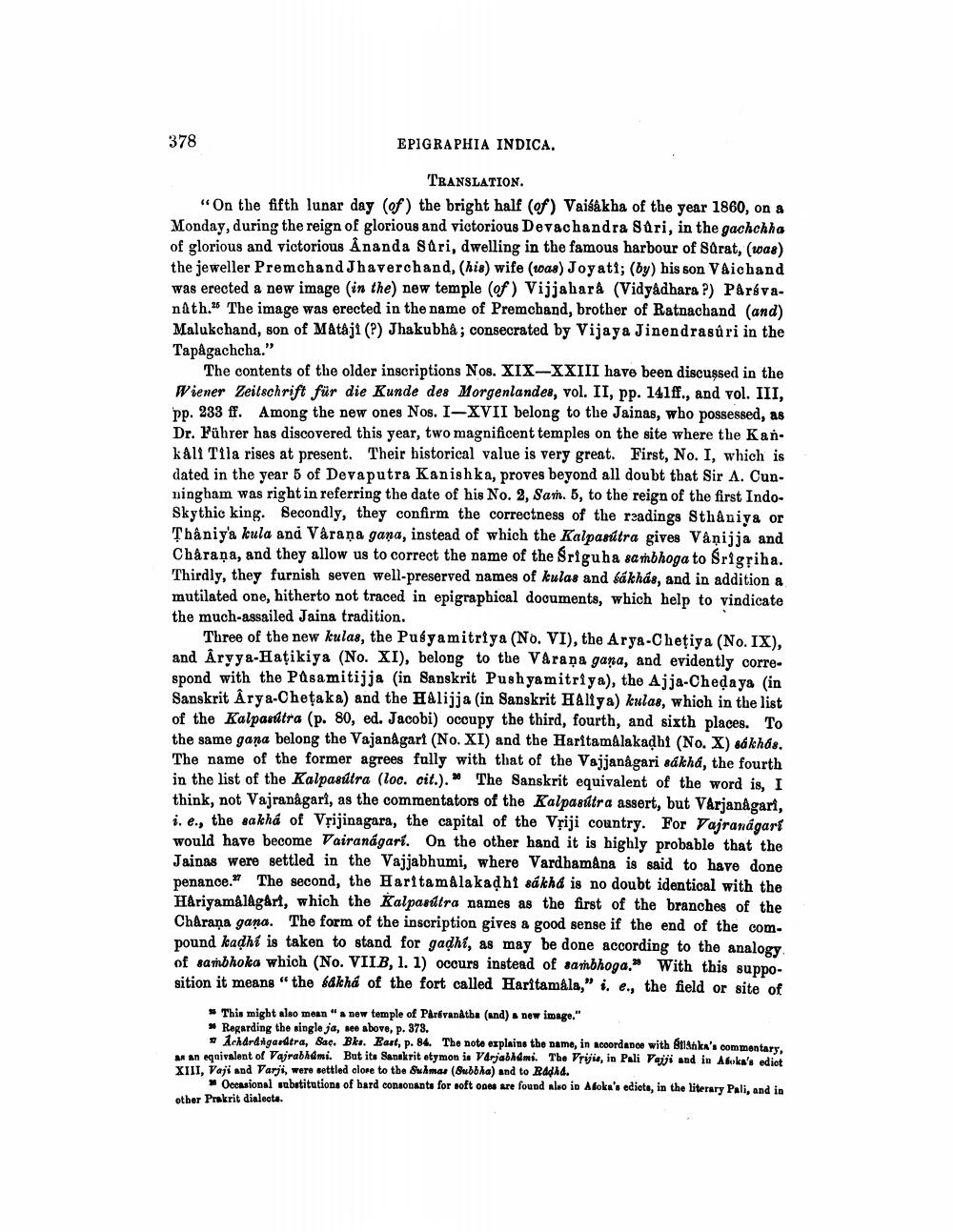________________
378
EPIGRAPHIA INDICA.
TRANSLATION.
"On the fifth lunar day (of) the bright half (of) Vaisakha of the year 1860, on a Monday, during the reign of glorious and victorious Devachandra Suri, in the gachchha of glorious and victorious Ananda Sari, dwelling in the famous harbour of Surat, (was) the jeweller Premchand Jhaverchand, (his) wife (was) Joyati; (by) his son Vâichand was erected a new image (in the) new temple (of) Vijjahará (Vidyadhara?) Právanath. The image was erected in the name of Premchand, brother of Ratnachand (and) Malukchand, son of Mataji (?) Jhakubhâ; consecrated by Vijaya Jinendrasûri in the Tapagachcha."
The contents of the older inscriptions Nos. XIX-XXIII have been discussed in the Wiener Zeitschrift für die Kunde des Morgenlandes, vol. II, pp. 141ff., and vol. III, pp. 233 ff. Among the new ones Nos. I-XVII belong to the Jainas, who possessed, as Dr. Führer has discovered this year, two magnificent temples on the site where the Kankali Tila rises at present. Their historical value is very great. First, No. I, which is dated in the year 5 of Devaputra Kanishka, proves beyond all doubt that Sir A. Cunningham was right in referring the date of his No. 2, Sam. 5, to the reign of the first IndoSkythic king. Secondly, they confirm the correctness of the readings Sthâniya or Thâniya kula and Varana gana, instead of which the Kalpasútra gives Vânijja and Chârana, and they allow us to correct the name of the Sriguha sambhoga to Srigriha. Thirdly, they furnish seven well-preserved names of kulas and sákhás, and in addition a mutilated one, hitherto not traced in epigraphical documents, which help to vindicate the much-assailed Jaina tradition.
Three of the new kalas, the Pusyamitriya (No. VI), the Arys-Chetiya (No. IX), and Aryya-Hatikiya (No. XI), belong to the Varana gana, and evidently correspond with the Pasamitijja (in Sanskrit Pushyamitriya), the Ajja-Chedaya (in Sanskrit Arya-Cheṭaka) and the Halijja (in Sanskrit Haliya) kulas, which in the list of the Kalpasútra (p. 80, ed. Jacobi) occupy the third, fourth, and sixth places. To the same gana belong the Vajanagart (No. XI) and the Haritamalakadhi (No. X) sákhás. The name of the former agrees fully with that of the Vajjanâgari sákhá, the fourth in the list of the Kalpasútra (loc. cit.)." The Sanskrit equivalent of the word is, I think, not Vajranâgart, as the commentators of the Kalpasútra assert, but Vârjanagari, i. e., the sakhá of Vrijinagara, the capital of the Vriji country. For Vajranagart would have become Vairanágari. On the other hand it is highly probable that the Jainas were settled in the Vajjabhumi, where Vardhamâna is said to have done penance. The second, the Haritamalakaḍhi sákhá is no doubt identical with the Hariyamalagart, which the Kalpasútra names as the first of the branches of the Charana gana. The form of the inscription gives a good sense if the end of the compound kadhi is taken to stand for gadhi, as may be done according to the analogy. of sambhoka which (No. VIIB, 1. 1) occurs instead of sambhoga." With this supposition it means "the sdkhá of the fort called Haritamála," i. e., the field or site of
This might also mean " a new temple of Parsvanatha (and) a new image." Regarding the single ja, see above, p. 373.
Acharangasútra, Sac. Bks. East, p. 84. The note explains the name, in accordance with Blanka's commentary, as an equivalent of Vajrabhami. But its Sanskrit etymon is Varjabhdmi. The Vrijis, in Pali Vajji and in Adoka's edict XIII, Vaji and Varji, were settled close to the Suhmas (Subbha) and to Radha.
Occasional substitutions of hard consonants for soft ones are found also in Afoka's edicts, in the literary Pali, and in other Prakrit dialects.




